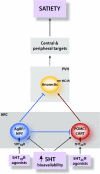Pharmacological targeting of the serotonergic system for the treatment of obesity
- PMID: 19029184
- PMCID: PMC2670022
- DOI: 10.1113/jphysiol.2008.164152
Pharmacological targeting of the serotonergic system for the treatment of obesity
Abstract
The attenuation of food intake as induced by an increase in serotonergic (5-hydroxytryptamine, 5-HT) efficacy has been a target of antiobesity pharmacotherapies. However, the induction of tolerance and/or side-effects limited the clinical utility of the earliest serotonin-related medications. With the global prevalence of obesity rising, there has been renewed interest in the manipulation of the serotonergic system as a point of pharmacological intervention. The serotonin(2C) receptor (5-HT(2C)R), serotonin(1B) (rodent)/serotonin(1Dbeta) (human) receptor (5-HT(1B/1Dbeta)R) and serotonin(6) receptor (5-HT(6)R) represent the most promising serotonin receptor therapeutic targets. Canonical serotonin receptor compounds have given way to a myriad of novel receptor-selective ligands, many of which have observable anorectic effects. Here we review serotonergic compounds reducing ingestive behaviour and discuss their clinical potential for the treatment of obesity.
Figures

References
-
- Abenhaim L, Moride Y, Brenot F, Rich S, Benichou J, Kurz X, Higenbottam T, Oakley C, Wouters E, Aubier M, Simonneau G, Begaud B. Appetite-suppressant drugs and the risk of primary pulmonary hypertension. International Primary Pulmonary Hypertension Study Group. N Engl J Med. 1996;335:609–616. - PubMed
-
- Adams DR, Bentley JM, Benwell KR, Bickerdike MJ, Bodkin CD, Cliffe IA, Dourish CT, George AR, Kennett GA, Knight AR, Malcolm CS, Mansell HL, Misra A, Quirk K, Roffey JR, Vickers SP. Pyrrolo (iso) quinoline derivatives as 5-HT (2C) receptor agonists. Bioorg Med Chem Lett. 2006;16:677–680. - PubMed
-
- Apfelbaum M, Vague P, Ziegler O, Hanotin C, Thomas F, Leutenegger E. Long-term maintenance of weight loss after a very-low-calorie diet: a randomized blinded trial of the efficacy and tolerability of sibutramine. Am J Med. 1999;106:179–184. - PubMed
-
- Balthasar N, Dalgaard LT, Lee CE, Yu J, Funahashi H, Williams T, Ferreira M, Tang V, McGovern RA, Kenny CD, Christiansen LM, Edelstein E, Choi B, Boss O, Aschkenasi C, Zhang CY, Mountjoy K, Kishi T, Elmquist JK, Lowell BB. Divergence of melanocortin pathways in the control of food intake and energy expenditure. Cell. 2005;123:493–505. - PubMed
-
- Barkeling B, Elfhag K, Rooth P, Rossner S. Short-term effects of sibutramine (Reductil) on appetite and eating behaviour and the long-term therapeutic outcome. Int J Obes Relat Metab Disord. 2003;27:693–700. - PubMed
Publication types
MeSH terms
Substances
Grants and funding
LinkOut - more resources
Full Text Sources
Medical

